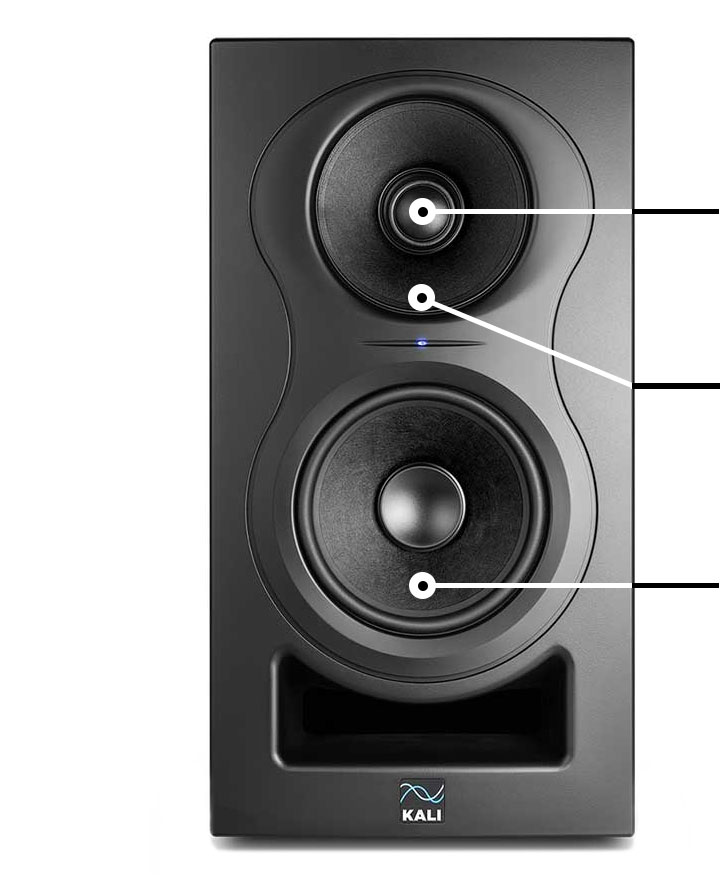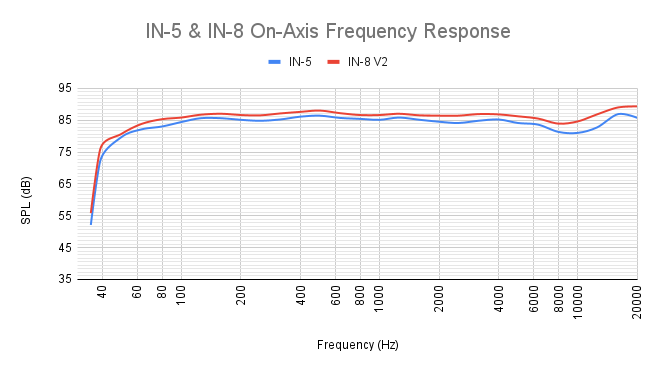



KALI AUDIO IN-8v2 ACTIVE STUDIO MONITOR -3-WAY BLACK 2nd WAVE (EACH)
 Call for availability
Call for availability
Kali IN-8v2 Monitor 3WAY
IN-8v2
Nate Baglyos, Kali’s Director of Marketing, says: The 2nd Wave Version of the IN-8 takes our already celebrated flagship speaker and adds all of the improvements that we’ve been able to realize with further research and development. We’ve eliminated the problem of self-noise and made significant headway in terms of system distortion. Acoustically, I feel confident that the 2nd Wave IN-8 is worthy of consideration alongside monitors several times its cost.”
The IN-8 is powered by a 140W Class D amp with 60W going to the woofer, and 40W each going to the midrange and tweeter. Boundary EQ settings, like those found on Kali’s Lone Pine monitors, are accessible on the back of the speaker, along with a quick reference guide printed directly onto the speaker itself. New for the 2nd Wave version is a boundary EQ for using the speaker horizontally on console bridges to improve sightlines.
2nd Wave
The 2nd Wave is our second generation of loudspeaker products. We’ve developed a new amplifier platform, and taken lessons that we’ve learned from our first (nearly) 3 years in business to enact several manufacturing improvements. The IN-5 is the first speaker to realise these improvements.
- Natural finish driver cones: Less material on the cone increases driver efficiency.
- Improved cabinet construction: For better cosmetic longevity.
- More robust DSP: For more precise tuning.
- New Boundary EQ Tunings: To take advantage of the fact that the IN-5 can be placed horizontally.
- Input sensitivity lowered by 3dB: For higher output from a given input signal.
- 140 W Class D Power
- 85 dB continuous output at 2.8 meters with 20 dB headroom
- Frequency Response (-10 dB:) 37 Hz-25 kHz
RRP: $999
Project Independence 8″ Studio Monitor
Kali’s IN-8v2 is one of the most innovative studio monitors ever made. Combining the natural advantages of a 3-way design with hyper-realistic imaging of a co-axial mid-range and tweeter, it offers more transparency, lower distortion, and a soundstage that must be heard to be believed.
PERFORMANCE
Power. Detail. Soundstage.
The IN-8 Studio Monitor is a speaker like no other. Using the same woofer and tweeter from Kali’s celebrated LP-8, the IN-8v2 adds a midrange driver that surrounds the tweeter, and acts as its waveguide.
In doing so, both the tweeter and the woofer are unburdened; with a smaller workload, they are able to play more clearly and with less distortion.
The coaxial nature of the midrange and tweeter make the IN-8 an acoustic point source. Off-axis lobing is thereby eliminated, resulting in a stereo soundstage that presents the listener with a hyper-realistic level of detail.
All of this means that the IN-8 is extremely accurate and easy to mix on, and that mixes made on the IN-8 will transfer wonderfully to other systems.
FEATURES
- Co-Axial Midrange and Tweeter
A three-way with impeccable imaging. - 8-Inch Woofer
Powerful, clean bass. Crossed over at 330 Hz to make the IN-8 an acoustic point source. - Low Noise Port Tube
Precisely engineered using airflow simulations for powerful bass without port noise.
IMAGING
We know. We keep harping on about the “hyper-realistic” imaging of the IN-8. What does that mean?
When you listen to a stereo set of speakers, you’re hearing information about where instruments and players were placed when the material was recorded. Even with purely digital material, producers can manipulate physical locations of elements in the mix, and you will hear these on a stereo recording.
Not only does this allow producers to create interesting spatial effects, but it means that you can work faster and with more confidence. An accurate soundstage lets you “see” each element of the mix in front of you, so you can hear exactly what happens when you make changes.
2-way systems with good waveguides, like Kali’s LP-6 and LP-8v2, do a good job at conveying this spatial information. However, because the tweeter and woofer on those speakers (and most studio monitors!) are separate, this information gets lost in the space immediately above and below the speaker. This means that at the listening position, you’re not hearing the full stereo picture.
The IN-8v2 solves this problem. The tweeter and midrange share an acoustic centre, and the woofer is crossed over at 330 Hz, so the distance between the woofer and midrange is well under a quarter wavelength at the crossover point. This means that the IN-8 is acoustically a point source. As such, it has the same excellent directivity that the LP-6 and LP-8 have at their sides in a full 360 degrees around the speaker. You’re hearing all of the spatial information at the listening position, so the soundstage that you hear will have every detail that’s present in the mix.
CLARITY
The IN-8’s total harmonic distortion is less than 1.4%, which is exceptional. This is the result of unburdening both the woofer and the tweeter, so that both are doing less work. The woofer is crossed over at 330 Hz, a full 2.5 octaves lower than on the LP-8.
The tweeter is crossed over at 3000 Hz, nearly an octave higher than on the LP-8. Taking up the space in between in the hero of the IN-8 system: the 4-Inch, profile-optimised midrange driver. This driver has a lot of work to do. In addition to reproducing midrange frequencies, it also acts as the waveguide for the tweeter. This means that the shape needed to be precisely engineered to provide an ideal dispersion characteristic for the tweeter.
It also means that the midrange needs to stay still. In many other co-axial or concentric systems, high excursion from the larger driver causes intermodulation distortion, and degrades the accuracy of the system. The midrange on the IN-8 is limited to less than 1 millimetre peak excursion, making it acoustically stationary while still providing midrange to keep up with the powerful woofer and tweeter.
EASE OF USE
Boundary EQ Control
A speaker’s given position in a space can drastically change it’s frequency response. A speaker placed against a wall or on a desk will sound very different than a speaker placed on a stand, even in a well-treated space. Hard surfaces like walls, desk tops, and recording consoles can change the low end frequency response of the monitor, and degrade the overall clarity of the sound.
Happily, most of the common positions are fairly predictable and easily corrected.
Kali’s team did our Boundary EQ tuning at The Village Studios in Los Angeles, and came up with boundary compensation EQ settings to help you get the optimum sound for where you need to put your speakers.
Combined with the LF and HF trims, this will ensure that the speakers sound their best no matter what room you’re mixing in, or where the speakers are placed.
https://www.youtube.com/watch?v=ypFQWkVIubQ
Performance
Unrivaled Punch and Detail.
The IN-Series monitors are unlike anything you’ve ever heard. The three-way design lets both the woofer and the tweeter do less work, resulting in better headroom and lower distortion across the frequency spectrum.
At the same time, the coaxial architecture of the midrange and tweeter result in hyper-realistic imaging. This means that you’ll be able to hear subtle details in your mix with pinpoint precision.
The design of the system comes together to allow the IN-Series monitors to act as acoustic point sources. They enjoy all the benefits of both traditional 3-way systems and traditional coaxial speakers, with none of the drawbacks traditionally associated with either.
All of this make the IN-5 and IN-8v2 extremely accurate and easy to mix on. You’ll be able to work faster and with more confidence, and your mixes are going to translate to other systems with less work.
IN-8v2:
140W
Class D Power
37 Hz
Lower Frequency Response
< 1% System THD
85 dB @ 1M
117 dB
Max SPL
Features

Soft Dome Tweeter
Smooth, effortless highs.Profile-optimized Midrange Driver
Clear mids and excellent directivity all the way to the top of the frequency response.Powerful Woofer
Clean, punchy bass that doesn’t disrupt the mids and highs.
| Custom Stock Status | Call for availability | ||||||||||||||||||||||||||||||||||||||||||||||||||||||
|---|---|---|---|---|---|---|---|---|---|---|---|---|---|---|---|---|---|---|---|---|---|---|---|---|---|---|---|---|---|---|---|---|---|---|---|---|---|---|---|---|---|---|---|---|---|---|---|---|---|---|---|---|---|---|---|
| Specification | Specifications
|
||||||||||||||||||||||||||||||||||||||||||||||||||||||
| Manufacturer | Kali |
||||||||||||||||||||||||||||||||||||||||||||||||||||||
| Package | 1 Pack |
Specifications
| IN-5 | IN-8 v2 | |
|---|---|---|
| Powered: | Yes | Yes |
| Amp Class: | D | D |
| DSP Functions: | Loudspeaker Tuning, Limiter, Crossover, Boundary EQ Settings | Loudspeaker Tuning, Limiter, Crossover, Boundary EQ Settings |
| Power Config: | Tri-Amped | Tri-Amped |
| LF Power: | 80 W | 60 W |
| Mid-Range Power: | 40 W | 40 W |
| HF Power: | 40 W | 40 W |
| Total Power: | 160 W | 140 W |
| LF Driver: | 5-Inch Paper | 8-Inch Paper |
| Mid-Range Driver: | 4-Inch Optimized Profile Paper | 4-Inch Optimized Profile Paper |
| HF Driver: | 1-Inch Textile Dome | 1-Inch Textile Dome |
| Freq. Response (-10 dB): | 39 Hz - 25 kHz | 37 Hz - 25 kHz |
| Freq. Range (±3 dB): | 47 Hz - 21 kHz | 45 Hz - 21 kHz |
| LF to Mid-Range Crossover: | 280 Hz | 280 Hz |
| Mid-Range to HF Crossover: | 2800 Hz | 2800 Hz |
| Recommended Listening Distance: | 0.2 - 2.2 Meters | 0.5 - 3.5 Meters |
| Max SPL: | 115 dB | 117 dB |






